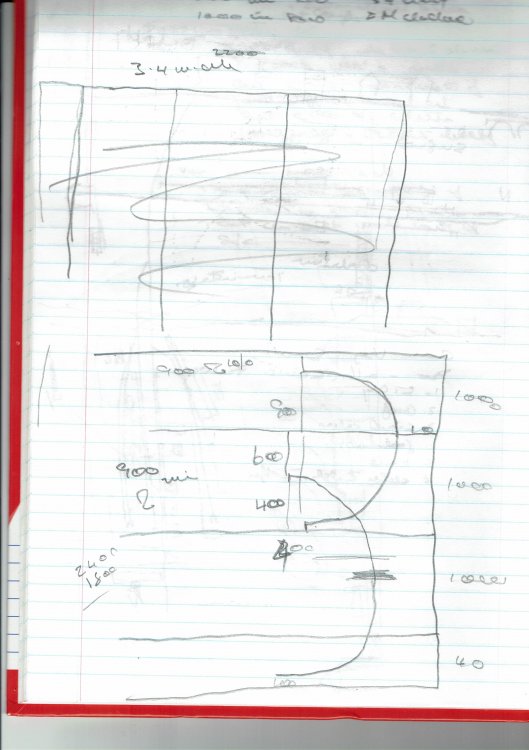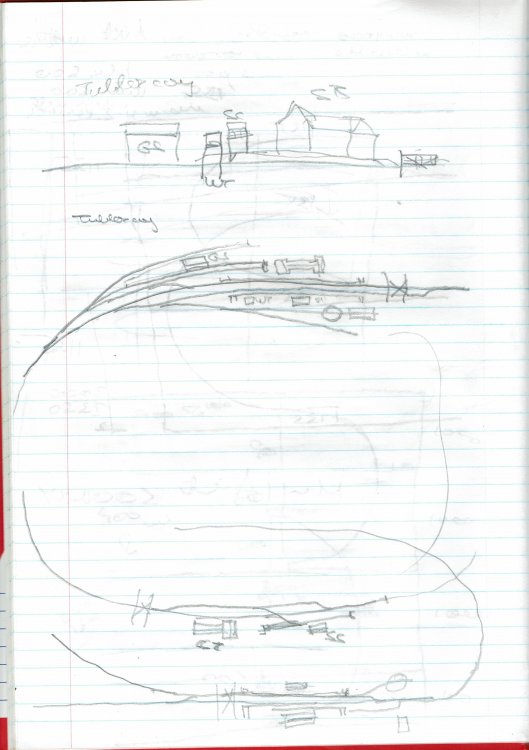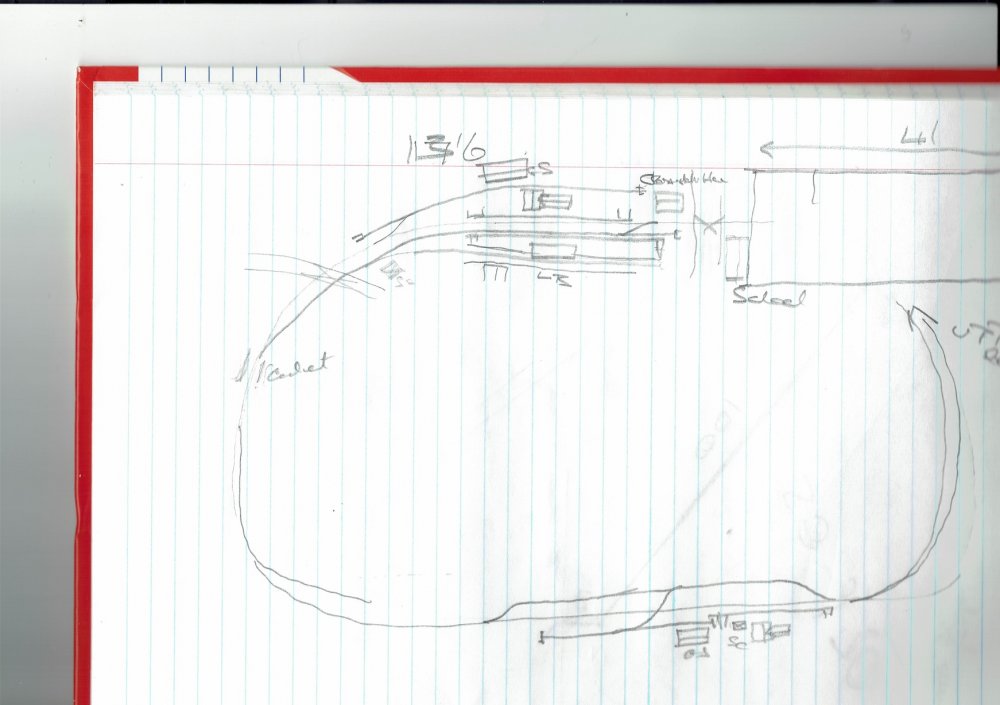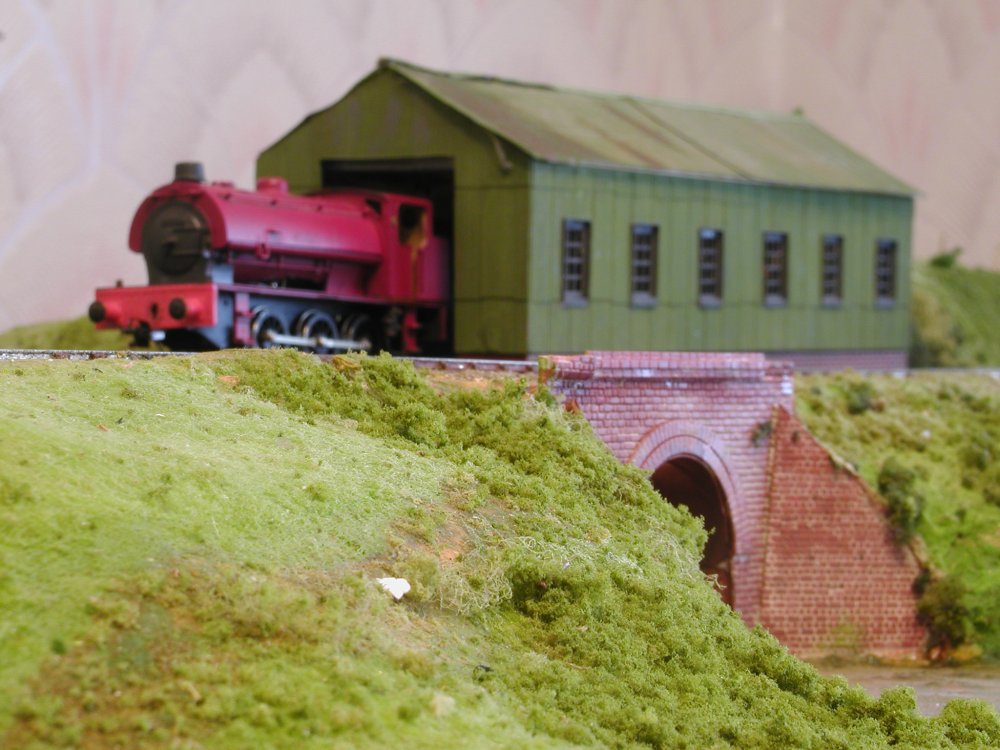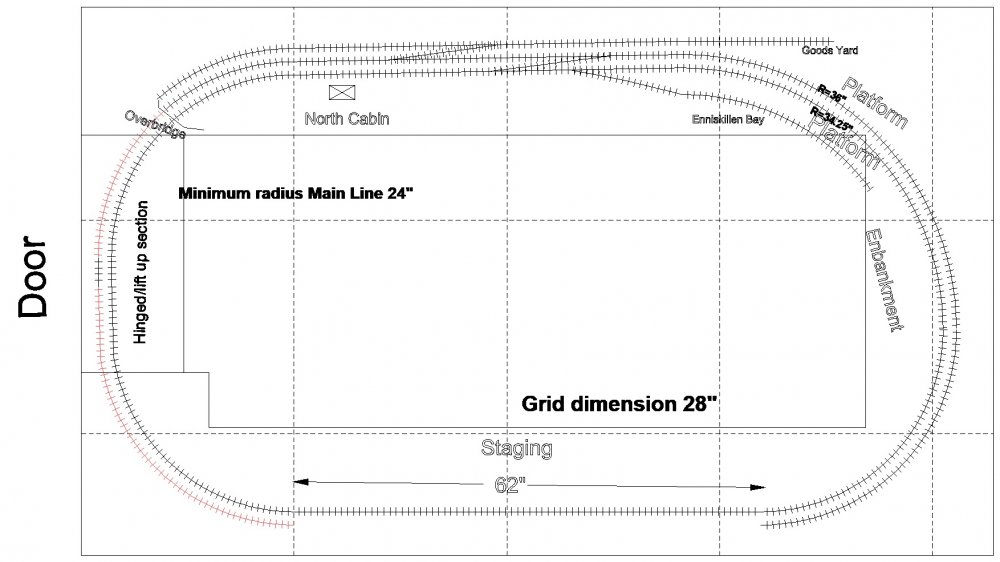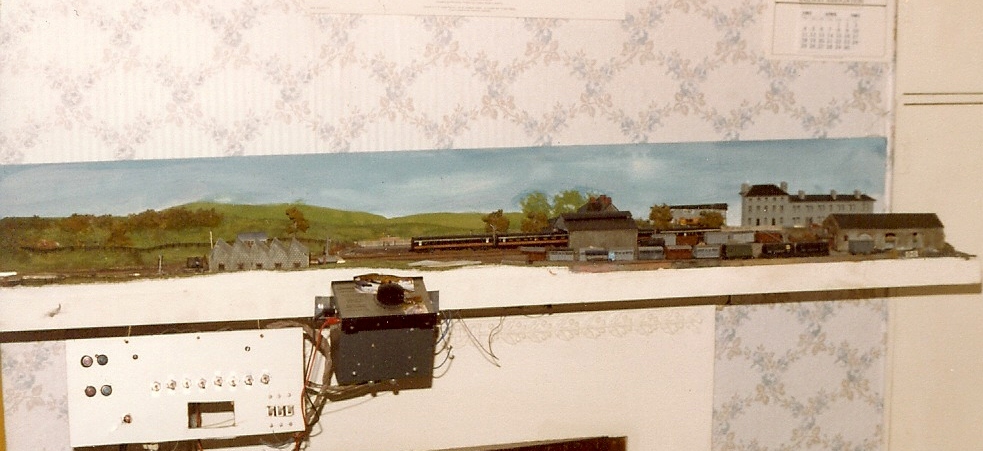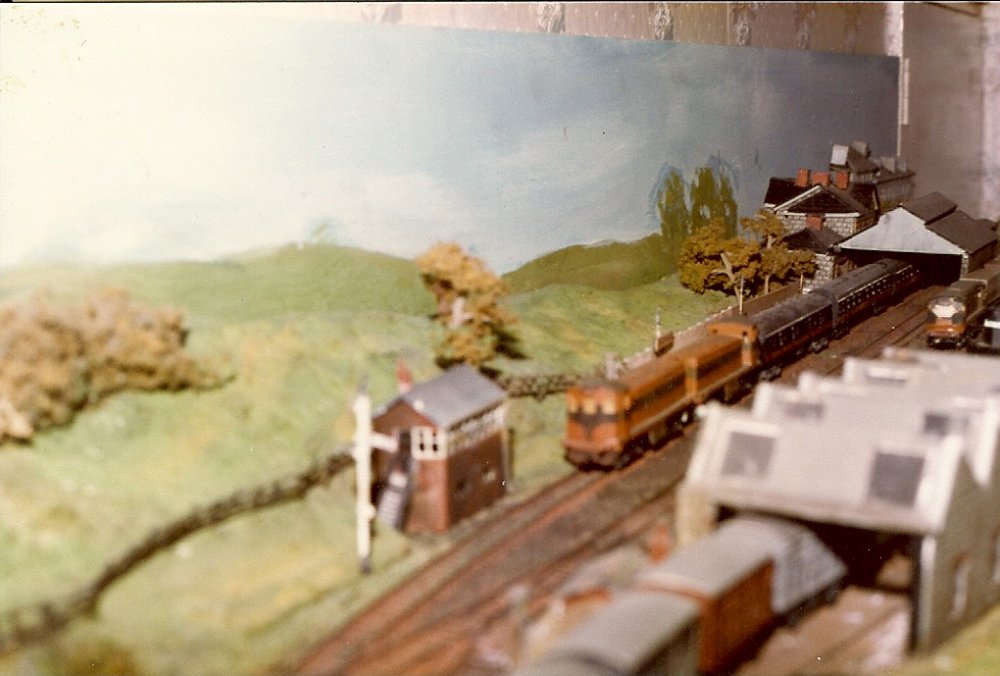-
Posts
4,879 -
Joined
-
Last visited
-
Days Won
119
Content Type
Profiles
Forums
Events
Gallery
Everything posted by Mayner
-
Automotive paint suppliers like Vinny Byrne's can usually supply enamel or laquer in spray can or for brush application if you have a BS or RAL code or a sample. Usually costs about $17 (not sure what you would pay in Ireland) for a 350ltr spray can of a custom colour My local paint supplier has successfully colour matched existing models, no shame in bringing a loco or coach into a paint suppliers, they are only interested in keeping the customer happy and bringing in the money. Transfer/decal carrier film tends to show up on a matt finish unless you use rub on decals. A gloss or satin enamel is the best option for locos and coaches and finishing with a satin or flat laquer if you intend to apply decals or transfers.
-
The small GMs basically replaced locos like the J15 on the goods and D14 on passenger services with a little extra power to spare as a diesel would not stand up to the same level of abuse as a steam loco. In an ideal world it would be nice to see 184, 186 & Lough Erne given at least a cosmetic restoration rather than stored out of sight out of mind
-
Ballinamore hub of the C&L narrow gauge lines in CIE days. A very busy place when the coal trains from the Arigna mines were running.
-
Dave I wasn't sure if the master for the Marks Models 201 was produced by Noel Dodd or Tony Mirolo both highly talented modelers. Are there any photos that could be posted of Noel's Greystones layout an Irish & UK exhibition staple of the mid-late 1990s? For those that are not familiar Greystones was a massive exhibition layout that featured a near scale length model of the station and its environment.
-
Dave. Have you managed to acquire a Marks Models resin 201 Class kit? As far as I recall the kits were cast from a master produced by an MRSI member who produced a fleet of plasticard 201s that ran on lengthened Athearn SD45 chassis during the mid-late 1990s. The scratchbuilt 201s were built and finished to a high standard and close to the standard of rtr diesel locos available at the time. John
-
I came across my planning notes from around four years ago, it looks like I considered a multi level end to end layout and a layout with an island in the center of the room before deciding on a single level U shaped scheme. I tested the center island concept by dividing the with of the room into 1m units based on a 900mm minimum radius & 100mm min distance from the edge of the square, I later prepared a scheme using 1136mm squares based on a minimum radius of 1000 for 21mm gauge, with a minimum aisle width of 500mm. I abandoned the center island concept as my workbench occupies the centre of the room. The main station in the initial plan was based on Kiltimagh, the second a typical of smaller stations on the Limerick-Sligo line with a goods loop and single siding, though the diamond crossing crossover arrangement is similar to Ferbane on the Banagher branch, at this stage I still seem to have had fantasies about an upper level. Kiltimagh did not work visually in the space available with most of the yard hemed in between the two level crossing gates. I eventually looked at Tubbercurry which appeared to be a better fit for the available space & the bonus of a loco shed and turntable, Ballingarne Junction seems to have slipped into the plan though I don't remember if this was intended to be part of a multi level or island set up. Hopefully I will find time during the next week to draw out the block plan for the folded 8 scheme to scale to see if the concept can be made to work in an Irish context., I may need to widen the baseboard to fit a hidden line into the area behind the main station.
-
I have used the Wills corrugated sheets for buildings on various layouts, including a loco shed, Wills also do a thin translucent sheeting which is useful for roofs where you dont want a thick edge showing https://www.modelrailwaysdirect.co.uk/Wills-Kits-SSMP216-Corrugated-Iron-4-sheets-(75x133mm)-per-pack/ ii you want something more realisitic Ambis Engineering EIW Corrugated sheeting http://www.ambisengineering.co.uk/Products/Products_Index.htm. The main advantage of the Wills sheets over the EIW sheeting, is that there is no need for a supporting structure.
-

Derry - Coleraine Train stops for plane!
Mayner replied to GNRi1959's topic in What's happening on the network?
Gisborne Airpost still has an operational level crossing controlled by miniature colour light signals. The line carries steam charter specials in connection with cruise ship visits. Air traffic normally has priority with the signals released by a tablet in the control tower http://www.amusingplanet.com/2013/08/gisborne-airport-runway-with-railway.html -
It looks like the was taken in the early-mid 1980s before the Bell Lines terminal was transferred to the Holyhead Yard and the run down of the Transtrack sundries services. Sundries traffic handled in the Midland Yard included a lot of high value urgent traffic including cigarettes, spirits, lubricating oil and motor parts which became a prime target for the growing logistic industry once road transport was de-regulated during the early 1990s. The sidings in the Midland Yard south of the Sherriff St bridge were used for loading/unloading general container traffic using large fork lifts, including scrap in open containers for the Galway Metal Company & grain traffic Up to the introduction of the IWT liners there was little direct wharf to rail container traffic through Dublin Port, the majority of rail borne container traffic through Dublin Port involved a road transfer from the Holyhead Yard to the container wharfs north and south of the Liffey. The Transtrack Store was built on the site of the old MGWR goods store which was destroyed by fire during the late 1960s. Most of track south of the Sherriff St bridge was abandoned in 2003 for the National Convention Centre and Treasury Holdings apartment developments and the remaining (Cork, Limerick & Ballina) container services diverted to the former groupage terminal on the north side of the Sherriff St bridge. The decision to run down freight and develop the North Wall site appears to have been as a result of Government pressure for CIE (Mary Harney as Minister of Transport) to cash in on its (under-utilised) assets to free up money for investment in passenger services. At the same time the closure of Asahi and failure of Bell Lines severely cut into the traffic base and profitability of rail while dis-functional labour relations within IE played into the hands of management and Merrion Street.
-
One of this years New Resolutions was to start some new builds along with finishing my un-finished projects. Top of the list were a pair of hooded vans for the mail and passenger trains as I did not keep any for myself when I released the vans in 2013. Following Eoin's example made a simple jig or fixture to temporary clamp the parts together while soldering the sides to the floor and ends. In this case I screwed the floor to a sheet of MDF and used a piece of stripwood to clamp the sides against the floor and ends until soldered in place. The ends on the JM Design 4w vans are designed as part of the floor and fold up into position to speed assembly, rather than assembled as separate parts.The doors are designed to fit into the recess, solder is locally sourced 139° with dilute "Ranex Rust Buster" (phosphoric acid solution). I usually use an Antex 55 W TCS Temperature Controlled Iron but I have recently graduated to a Hakko Soldering Station The vans were built on Bulleid Triangulated chassis with the usual Inchacore bufferbeam arrangement with the flanges facing outwards, tricky to form from flat metal parts. Designing a workable arrangement for the underframe was tricky as the axleguards/W irons usually fit behind the underframe channels, designing a headstock/buffer beam that would fold up easily was challenging to say the least. 1 Solebar one buffer beam. Folding up solebar flange in vice . The finished article The head wrecking stuff folding up the buffer beams! Fold 1 Fold 2 Completing the channel/fold 2 Completed buffer beam in position Van with solebars and buffer beams soldered in place. Solebar folded up and held in position for soldering An evenings work. Next stage running and brake gear
-
I have been working on and off over the past 10 years converting our garage into a model railway room. The garage like our house is timber frame and weather board construction dating from the mid 1920s probably intended for the owners Model T Ford. When we moved in the garage had a distinctive lean the timber (Totara) piled foundations had rotted away. Luckily the framing was generally in good condition and we were able to level up and re-pile and renovate the interior of the garage as a model railway room/workshop. Although I installed the baseboard framing nearly three years ago, there has been little or no progress on the layout, which had become a repository for rubbish and half completed models. This week I finally managed to clear out some of the clutter in the garage and start thinking about planning the railway. The baseboards for the 4mm layout are approx 1.4m above floor level above storage shelving and the Staging for the garden railway. The initial plan was for a U shaped layout around 3 of the walls, until I get round to replacing the roller shutter garage doors with a conventional doorway. One of the spurs for renewed interest in the layout was that we are likely to remain in Hamilton for at least another 7 years. I have a history of having to move once I make good progress on a layout. The original plan was for a single track point to point layout with a minimum of two stations running to hidden staging at each end, based on the Limerick-Sligo line. The option of building the layout as a continuous run opens up the idea of a looped 8 style tracklayout doubling the length of the main line and increasing the distance between stations, with what the Americans call "Surround Staging" where the staging is sited behind a scenic break around the perimeter of a layout rather than a traditional fiddle or staging yard. I used this technique on a N gauge layout where the 6 road staging yard was hidden behind a low backdrop at the back of the main yard. I am planning to build most of the layout using open top baseboards using a variant of the American L Girder system where the trackbed is supported on risers fixed to crossbearers, part of the layout is supported on L Girders salvaged from a layout I had started in Auckland . The staging track will be laid at a lower level than the scenic section, the Mail train is supposed to be posed on an embankment, the E Class and wagons in the staging. At some stage the folded 8 will have to cross over itself which will either involve a crossover very unusual in Ireland or an overpass to allow one line to pass above another with interesting grades. The current staging set up is based on a traverser which runs on kitchen drawer slides. This allows longer trains to be staged in a given space compared with using a turnout ladder, but 1200mm is short for a main line goods or passenger trains. Next stage is to rough out a block design for the main line to see if I can make the idea of "Surround Staging" work for a 4mm layout on 500mm wide baseboards & to clear the remaining clutter from the baseboard tops Irish stock MM B141 diesel Shapeways E421on Bullant chassis with my detail overlays, JM Design heating Van & 4w PO van, SSM GNR 30T Brake & modified Parkside BR vanfits The train in the second is part of an EM gauge minimum space Welsh Borders effort using "floating trackwork" which did not quite work. The loco is an Airfix Dean Goods on a brass chassis (with motor in the engine!) coupled to a City of Truro tender and a mixture of Cambrian, Parkside and Airfix wagons
-
I was planning to scratch build a C&L 4-4-0T and had even bought a set of driving and bogie wheels shortly before Backwoods Miniatures introduced a kit for the loco and other items of C&L rolling stock. Modelling the C&L suddenly became a lot easier in the mid 1990s thanks to the combination of Backwoods Miniatures, Branchlines & Worsley Works, loco, coach and wagon kits. 2L formerly Kathleen now preserved in the UFTM Cultra ()etched brass/whitemetal) 8L (Queen Victoria) as running late 1950s. Van 22L rebuilt Tralee & Dingle brake 3rd as running on C&L in mid 1950s (etched brass) Convertible wagons (Brass & Whitemetal) The convertibles had a whitemetal body on a brass chassis. The wagon modeled by Backwoods was unusual in that all 4 sides were different, the prototype wagon had lost some of its louvers and had a planked door on 1 side C&L 4w passenger brake. (brass) Backwoods appear to have taken a bit of modelers license with the paneling on passenger brake. Paneling was modified/simplified as vans were repaired/overhauled during the GSR/CIE era and eventually re-clad in aluminium sheeting. The coach is a Branchlines CVR 3rd
-
The lack of commercial success of the Backwoods Miniatures 4mm Irish kits may be a bigger factor affecting the re-introduction the kits or the introduction of the range in 7mm than any issues alleged issues involving the artwork I bought and assembled a number of Backwoods Miniatures Irish narrow gauge kits and spoke to Pete McParlin the designer/owner of the business on a number of occasions during the past 20 year Pete not consider the Irish kits to be a commercial success and focused increasingly on the OO9 and On30 American market including commissioning rtr on30 brass locos from China. Backwoods produced the Irish kits to special order since around 1996-7 presumably ordering the etchings as required until until their stock of castings, wheels gears and motors ran out. When we last spoke about 4-5 years ago Pete told me that he failed to sell a single CVR 0-4-2T kit since its introduction in 1993-4. The display model of the CVR loco looked very nice, with skirts raised on one side to display the joy valve gear. The loco kits were reasonably priced for complete kits including wheels gears and motor. Backwoods used a combination of on-line and magazine advertising and attending specialist narrow gauge and major model railway exhibitions including a display of painted and assembled kits including the CVR 0-4-2T. In retrospect Backwoods made the mistake of overestimating the level of interest in OOn3 models of Irish locos and stock following the early success with the OO9/OOn3 County Donegal Railcars and simply introduced a very diverse range of Irish OOn3 locos and stock that the market could not support. John
-
Hi Tony Have you considered using a lifting bar flap section immediately inside the door for your continuous run? This would allow you to both maximise the length of the continuous run and extend the length of the headshunt at the Northern end of the yard. I have sketched out a rough block plan based on Omagh North with a bar flap just inside the doorway, it might be worth building the layout as a double tracked layout as there is no room for a crossover on the curve at the Portadown/Enniskillen end of the station with a min radius of 34" through the platform roads. The 28" grid is based on an American planning tool to work out whether a curve will fit within a given space. (24" minimum radius plus 4" allowance to outer edge of baseboard. This would allow you a lot more operational flexibility than with the bridging section half way across the operating well, the ability to have two trains running continuously or the operational complexity when the Irish North West was in operation with through Belfast-Bundoran excursions in addition to goods and passenger traffic from the Irish North Fitting in staging with a conventional turnouts would be difficult on the opposite side, one solution might be to build a traverser style fiddle yard https://www.google.co.nz/search?q=traverser+fiddle+yard&rlz=1C1CHBF_enNZ752NZ752&tbm=isch&tbo=u&source=univ&sa=X&ved=0ahUKEwjf4s6eqZjZAhWMVLwKHVOfA6wQ7AkIMg&biw=1366&bih=662 This would work nicely if you raise the trackbed on a raised sub-base with most of the viewing side of the station on an embankment.
-
Probably build the RGS from Placerville to Rico & the Telluride Branch in 1:20.3 (if I hire an Antonov An223 to shift my large scale collection from Hamilton to Fargo) there is enough room and plenty of provisions in the basement. Would be an interesting foil on You Tube to Bill Scobies RGS in Canada https://www.youtube.com/watch?v=IvuhJqMNJqc Model shops in the state only appear to stock BNSF, though being me would probably model some obscure shortline or offshoot of the CP or Milwaukee Road
-
The hobby was firmly focused on modelling rather than collecting rtr models as the availability of rtr models was highly limited at the time. All the model railway magazines ran regular articles on kit building and scratchbuilding locomotive, rolling stock and buildings, model railway shops even in Ireland stocked detail parts, wheels and motors and experienced modelers in the model railway clubs were supportive In the early 70s Irish railways were becoming more popular as a subject both for modelers who wanted something a bit different from BR, The Big Four. Irish layouts were starting to appear at exhibitions and articles on modelling Irish railways starting to appear in magazines with Tim Cramer publishing a series of articles from the 70s onwards in the Constructor, The Modeler, Model Railways and eventually British Railway Modelling. Brian McCann's Bagnallstown encourage me to try N gauge initially with a folding 8X2 model of Kilmessan Junction (too cramped) that led me on to an 11X11 point to point and eventually a couple of reasonably large N Gauge American layouts, while I focused my rolling stock building efforts in 4mm scale British and Irish outline. While my current layout (10 years to build) is 45mm gauge American 3' gauge in the garden, I am undecided on the future of my American N Scale collection as I may need it some time when I down scale to a smaller property, I might even get something running in 21mm gauge. John
-
Setting up a group to support/fund the overhaul of a locomotive on an existing narrow gauge line is a more practical proposition. Its unlikely the promoters of the group understand the costs involved in overhauling even a small narrow gauge steam locomotive (over £150k for Russell 2' gauge 2-6-2t mechanical overhaul, re-tube boiler) it will be interesting to see how much supporters pould be prepared to pledge/subscribe to the restoration of Dromad annually
-
In my late teens/early 20s I built a reasonably successful Irish N scale layout around the walls of my 11X11, looking back probably my most successful and long lived layouts. The main reason for down -scaling from OO to N was out of frustration of trying to get something running in OO in an 8X6 box room and poor running quality of contemporary OO. My main inspiration was Brian McCann's Bagnallstown layout which was on the Irish exhibition scene in the 70s & 80s a folded dog-bone layout which featured a model of the station, the Thomastown and Barrow Viaducts. The layout featured typical trains of the period including an AEC Railcar set, a CIE Supertrain, a conventional passenger train and contemporary goods stock including loose coupled stock and Tara & Ammonia wagons. The locos and stock were modified/re-painted rtr, the Rivarossi Italian diesel with porthole windows was the main stay of the loco stud, the contemporary Lima N gauge motor was best described as disposable! B121s waiting to depart on a Dublin passenger, B141 in the yard on the Liner. Redundant cattle? wagons stored in the loco shed. The B121s & 141s ran on Atlas/Rivarossi SW1500 chassis, 001 Class on Atlas GP30 Chassis (wrong number of wheels but excellent hauling power slow running for loose coupled goods work) While I kitbashed diesels and steam locos to look like Irish stock, the focus was more on modelling the railway and its environment than individual items of rolling stock. The fact that the coaches and wagons in a train are re-painted British r-t-r is not immediately obvious from the normal 2' viewing distance, but a pair of 121s and 5-6 miscellaneous coaches signals that the train is likely to be a through train on a second string main line from Connolly or Heuston to a destination in the West or South East, a 001 Class and 15 wagons an overnight goods from Heuston Goods or NorthWall Midland nearing its destination, a B141 & 2 bogie vans a mail or Newspaper train serving some provincial destination. General view of the main station passenger train under the overall roof H vans on the goods shed road, cattle wagons and tank wagons oon the middle and cattle bank roads. Interestingly I also built a built a plasticard B141 (hand) cutting out the parts and assembly was simple enough, but painting the loco was a bit of a struggle. All I had at the time was cheap instamatic camera so no close up photos of the locos or stock. The 001 was formed literally from a 0.30" plasticard box with 0.10" detail overlay similar to David Jenkinson's recommendations for 7mm coach building. .
-
Patrick: Interesting to see an Irish layout set up for classical 'walk around' operation common enough for American layouts in basements and garages/garden sheds but probably unique for an Irish layout. We are half serious thinking of spending some of our time each year in the States when I retire and build a layout in my Father-in-laws basement in North Dakota, listen to trains on the CP line at the back of the house and watch Fargo on the tv while snowed in in the Winter.
-
Nothing , its not really practicable to model the soleplate and fangbolt fixing used with flatbottom rail on wooden sleepers I just solder the rail directly to the sleepers, the secret is liquid flux between the foot of the rail and sleeper and very little flux on the tip of the soldering iron
-
The trackwork on the Loughrea layout was mainly installed in the early-mid 1990s by the late Frank Davis who was a very talented EM gauge modeller, his Wentworth Layout was exhibited at several Irish exhibitions North and South and Warley 2005? I used to be one of Frank's roadies taking both Loughrea and Wentworth to exhibitions in Ireland The trackwork on Loughrea used flatbottom rail laid on plywood sleepers with a brass rivet fixing the so called Brook Smith system pioneered in the 1950s and commonly used in EM & S4 up to the widespread introduction of abs plastic chairs for bullhead track in the late 1980s The two main drawbacks with Loughrea as a layout which probably lead to few people within the club taking up 21mm gauge was that the station yard took up a lot of space being built to scale length and was not very interesting from a viewers or operators perspective. A German lady who had not visited the area remarked that the station and landscape looked rather bleak! Another probably bigger issue was that our collection of 21mm gauge locos and stock had far outgrown a sleepy country branch line, including MIR diesels hauling block trains of bulk cement and Esso tank wagons, an IE MK3 push pull set, SSM GNR locos and passenger stock, SSM J15s & GSWR 6 wheel stock but very little in the way of MGWR stock apart from a couple of TMD/SSM J26 and some scratchbuilt goods brakes Visually a short cut of wagons or a 2-3 coach train tended to be lost within the expanse of the yard. Operationally the main drawback was that it was difficult to have two locomotives operating simultaneously. The long headshunt at the Attymon end of the station was shortened effectively blocking shunting of the cattle bank and run round loop while the main line was occupied by an arriving or departing train. We looked at a number of options to make operation more flexible/interesting including trackwork alterations including converting the carriage siding to a loop and extending the head shunt to allow the loco of a passenger or mixed train to run round, turn or shunt the Goods Shed Road, while another loco was simultaneously shunting the Cattle Bank road. The alterations probably took the layout too far from the original concept and the track layout appears to have reverted to its original state
-
I may be missing something lot of discussion on the subject and not a single example of 21mm gauge track. I started work on a 7'6" X 5' L shaped dock layout in 2011 inspired by the North Wall Lines. The basic idea was set of canal side reception sidings serving a tramway connection to the quays. The layout never got past the initial stages as I did not allow sufficient space between the running line and the yard tracks. The other problem was there was simply not enough space to give a realistic transition from the straight approach roads to the curved section of the layout. The ordinary 1:6 points were fine the double slip challenging. Rail was surplus Code 82 rail from Atlas flexible track on copper clad sleepers. The trackwork was prefabricated in sections off the baseboard, wired, tested and painted before being secured in place and ballasted.
-
Hand laid track using copper clad construction is a lot cheaper and flexible in design than Peco or other ready to use track systems. Soldered track with copper clad sleepers is very strong and easy to adjust wide or tight spots something that difficult to do with the much more expensive C&L & Exactoscale systems. Current Marcway/SMP prices 6yds Code 100 N/S rail £9.50 6yds Code 75N/s £ 8.25 Copper clad 8'6" sleepers 100-------------- £10 1000------------£90 Sleeper strip for points 12- £10.95. Many modelers use a combination of ply and copper clad sleepers with 1:5 sleepers in copper clad.
-
The question of whether scratchbuilding or kit building over buying rtr is a false economy depends really on whether a person derives their satisfaction from collecting or modelling I went through a phase of building BR steam locos from DJH & Comet kits about 20 years ago some speculatively, some as commissions, and some for myself. On average a kit for a large loco like a West Country or 9F 2-10-0 took 30 hours to build and sold for upwards of £250 with material costs of around £100. One of the frustrating things was that Bachmann or Hornby tended to release a rtr version within 6-12 months of completing a model of a particular loco, but the satisfaction of completing a particular loco was far higher than opening a box. A kit or scratchbuilt built loco with metal boiler, brass frames, quality Mashima motor with all metal gear train likely to perform better and last far longer than a rtr loco with mazak chassis and plastic gear train. Some of my kit built Irish steam locos are upward of 30 years old and still run reasonably well while most of my British outline rtr locos of that age are only fit for the scrap box.
-
.Eoin I might be worth looking at the Lifelike SW9/1200 or Micritrain SW1500 switcher chassis for a B141 Class. Altas produce a MP15 which has a longer frame than the SW locos. I used the old Atlas/Rivarossi SW1500 switcher as a chassis for a plasticard B141 and a pair of 121s about 40 years ago, from memory the SW1500 chassis was pretty close in terms of overall length.
- 55 replies
-
- 1
-

-
- 141 gauge n
- 141
-
(and 1 more)
Tagged with:
.png.c363cdf5c3fb7955cd92a55eb6dbbae0.png)

